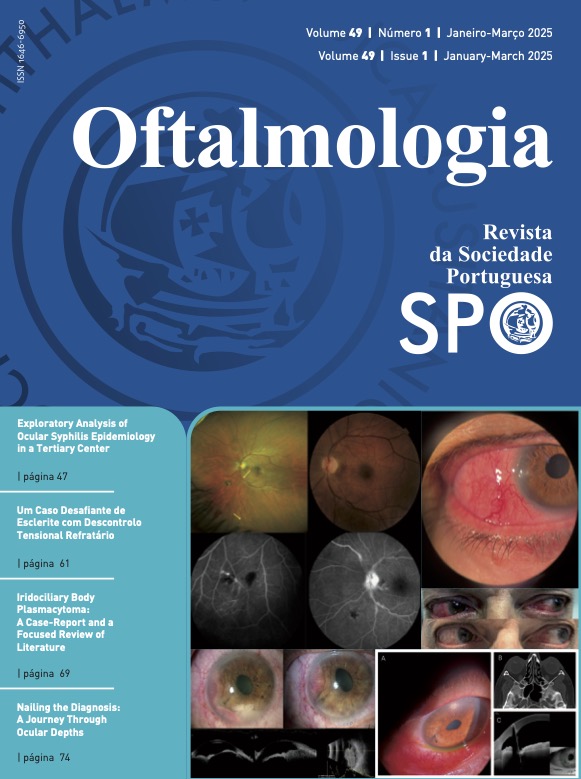Efficacious Application of Amniotic Membrane in the Surgical Management of Combined Mine-Explosive Corneal Injuries
DOI:
https://doi.org/10.48560/rspo.35590Keywords:
Amnion/transplantation, Corneal Injuries/surgery, Explosions, Explosive Agents, Military Personnel, UkraineAbstract
INTRODUCTION: Mine-explosive eye injuries, primarily affecting the cornea, occur due to several damaging factors from an explosive device. Several surgical methods stimulate corneal regeneration, including amnion transplantation, limbal stem cells from another healthy eye, induced pluripotent stem cells, mesenchymal stem cells, and bioprinting. Amniotic membrane transplantation prevents vascularization and fibrosis, improving reparative properties without causing transplant rejection, while the last three methods are still in clinical research stages. Our objective was to evaluate the results of the surgical strategy for addressing combined mine-explosive corneal injuries.METHODS: A retrospective analysis of 22 cases (22 eyes) of military personnel with mine-explosive corneal injuries (22 men, aged 30-45 years) revealed promising outcomes. All patients were submitted to a first surgical approach to stabilize the cornea, and then: first group: secondary surgical intervention including amniotic bio coating followed by conservative measures; versus second group: secondary surgical intervention followed by conservative measures and delayed amniotic membrane transplantation. Treatment effectiveness was assessed by analyzing indicators such as corneal syndrome (photophobia, lacrimation, blepharospasm), corneal edema (biomicroscopy/OCT), neovascularization, and transplant rejection over a 3-month period (July to October 2023).
RESULTS: During the three-month observation period, neither group exhibited signs of transplant rejection or corneal neovascularization. Group I had a mean time to improvement of 3.64 ± 0.77 days, with a median of 4 days. Group II had a mean time to improvement of 6.55 ± 1.30 days, with a median of 7 days. Both groups showed positive dynamics in reducing corneal edema over three months. Group I demonstrated significant reduction in corneal thickness both at 1 month and at 3 months (by 18.56%). Group II also showed a reduction in corneal thickness, but less pronounced (by 5.88%). These results indicate a significantly faster and more pronounced decrease in corneal edema in Group I compared to Group II over the three-month period (t = 2.96, p = 0.008).
CONCLUSION: Managing mine-explosive corneal injuries presents formidable challenges. The concurrent implementation of surgical intervention and amniotic bio-coating exhibited notable efficacy, mitigating corneal syndrome, and decreasing corneal edema and inflammation, thus promoting corneal regeneration.
Downloads
References
Robert Scott. The injured eye. Philos Trans R Soc Lond B Biol Sci. 2011; 366: 251–60. doi: 10.1098/rstb.2010.0234
Stuart A. Emerging Strategies in Corneal Regeneration. Chicago: American Academy of Ophthalmology; 2021 [accessed Jan 2024] Available at: https://www.aao.org/eyenet/article/emerging-strategies-in-corneal-regeneration
Baig IF, Le NT, Al-Mohtaseb Z. Amniotic membrane transplantation: an updated clinical review for the ophthalmologist. Ann Eye Sci. 2023;8. doi: 10.21037/aes-22-5
Nowomiejska K, Adamczyk K, Haszcz D, Preys N, Rejdak R. Case report: Bilateral eye injuries in members of one family due to a cluster munition in Ukraine. Front Med. 2023;10:1171954. doi: 10.3389/fmed.2023.1171954.
Prat D, Tsumi E, Madgar S, Goldberg H, Zloto O, Osaadon P, et al. Ocular injuries incurred by Israeli defense forces during low-intensity conflicts. Injury. 2021;52:292-8. doi: 10.1016/j.injury.2020.09.041.
Willmann D, Fu L, Melanson SW. Corneal Injury. In: Stat-Pearls. Treasure Island: StatPearls Publishing; 2024.
Walkden A. Amniotic Membrane Transplantation in Ophthalmology: An Updated Perspective. Clin Ophthalmol. 2020;14:2057-72. doi: 10.2147/OPTH.S208008.
Linhares AC, Martinelli AC, Ghem MR, Dias PB, Wasilewski D. Amniotic membrane transplantation for neurotrophic corneal ulcers. Arq Bras Oftalmol. 2024;87:e20220341. doi: 10.5935/0004-2749.2023-2022-0341.
Gheorghe A, Pop M, Burcea M, Serban M. New clinical application of amniotic membrane transplant for ocular surface disease. J Med Life. 2016;9:177-9.
Nagpal R, Maharana PK, Roop P, Murthy SI, Rapuano CJ, Titiyal JS, et al. Phototherapeutic keratectomy. Surv Ophthalmol. 2020;65:79-108. doi: 10.1016/j.survophthal.2019.07.002.
Downloads
Published
How to Cite
Issue
Section
License
Copyright (c) 2024 Revista Sociedade Portuguesa de Oftalmologia

This work is licensed under a Creative Commons Attribution-NonCommercial 4.0 International License.
Do not forget to download the Authorship responsibility statement/Authorization for Publication and Conflict of Interest.
The article can only be submitted with these two documents.
To obtain the Authorship responsibility statement/Authorization for Publication file, click here.
To obtain the Conflict of Interest file (ICMJE template), click here





